 |
 |
 |
|
|
Above, an Iowa class ship is firing two thirds of a broadsides. Only the outer two barrels on each turret are firing. This is done to reduce shock. For every action, there is an equal and opposite reaction. When nine 2,700 pound projectiles are kicked out at 2,300 feet per second, even a 45 ton battleship feels the recoil. As the Iowa's aged in service, they ceased firing full nine gun broadsides. Even this six gun discharge was a photo opportunity, not the standard practice. Normally, the guns would be rippled off, each gun fired independently. The only reason to let loose even six guns at once is because it looks cool.
Assuming full charges of six bags of propellant for each of the six guns being fired, the above discharge represents 36 bags of propellant. Looking at the fire and water, one cannot help but be impressed by the sheer power. Let's crunch a few numbers. Massachusetts carried over 3,000 rounds of sixteen inch ammunition. To fire these off, Massachusetts carried over 18,000 bags of propellant. Roughly 12,000 bags would be in the forward powder magazines, servicing turrets one and two.
Use your imagination. The above picture represents the detonation of 36 bags of propellant. Imagine 12,000 bags going off at once. Boom, splash, and the ship is gone.
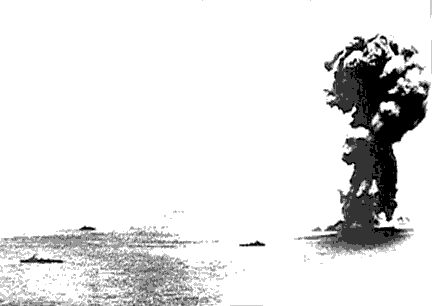 |
|
The magazines of the largest battleship built detonate. |
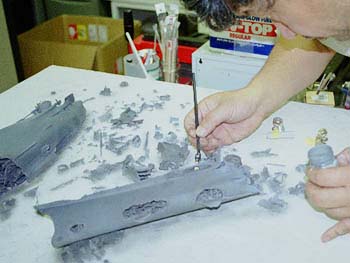 |
 |
|
From a Tamyia web page. |
This is an argument for "all or nothing" battleship design. The armor really must protect the magazines from the guns one expects to fight. One of the first shots Bismarck fired in anger found H.M.S. Hood's main magazine, and ended the fight right there. Hood was a battle cruiser, designed to fight anything she could not out run, and out run anything she could not fight. An excellent concept, but the ability to run meant saving weight, which meant her magazines were not protected from a battleship's weapons. Thus, the possibility of catastrophic hits.
Preventing opposition shells from reaching one's primary magazines is not a luxury in battleship design. If one must sacrifice weight and armor in the bow and stern to protect the magazines, one does so.
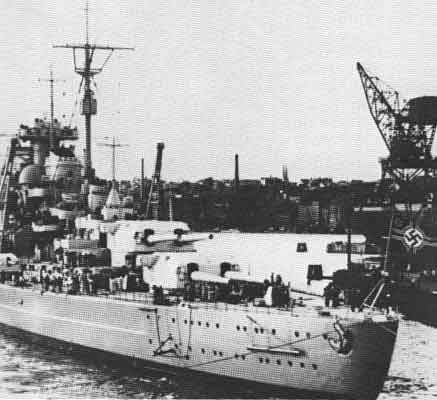 |
|
Note the portholes begin only aft of the main turrets. The amidships "citadel" armor belt can have no such weaknesses. The US fast battleships had no hull portholes, even outside the citadel area. |
This is also an argument for safety. The USS Iowa was not the only US battleship to suffer a turret explosion. Iowa's ready ammunition for one salvo detonated prematurely. However, the flash did not penetrate back through the turret into the magazines. This page might begin to explain why.
 |
|
|
The above is a safe passage for one bag of propellant. To the right, on the far side of the partition, to the outside, is the main powder magazine. To the left, through another identical safe passage, is the interior of the turret. The room shown is a circular passage that immediately surrounds the turret. The safes are designed to pass the propellant through the wall while at no time exposing one side of the wall to blast effects from the other. This ring room, surrounding the turret, has three pairs of such safes, one pair for each gun being serviced. During firing, three sailors manned this ring, one at each pair of safes, their sole job being to pass ammunition through the double safeguard. Outside the ring, other sailors passed bags of propellant to the outside of the outer safe. Inside...
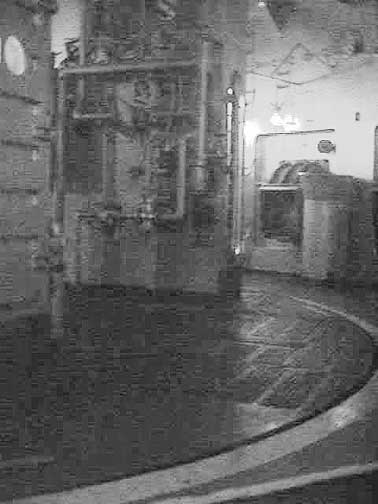 |
|
Lower right, the circular curve of a turntable that moves with the turret. Upper right, another powder shuttle, for passing in propellant. Center, the back of a powder hoist. Left, the corner of a double hoist. |
A battleship is big, but most to all spaces below decks are cramped. The ship was deliberately divided into many watertight compartments. Each room has a function, and is generally crowded with machinery intended to fill this function. One rapidly gets used to tight spaces.
Coming to the balcony room under Turret Two is a mild surprise. Two floors of mostly open space seems luxurious after walking the rest of the ship. The outer walls of the room are fixed. The bulk of the center of the room is a turntable - the bottom of Turret Two - and turns with the turret. The two rectangular columns are powder hoists, to carry power bags up to the guns.
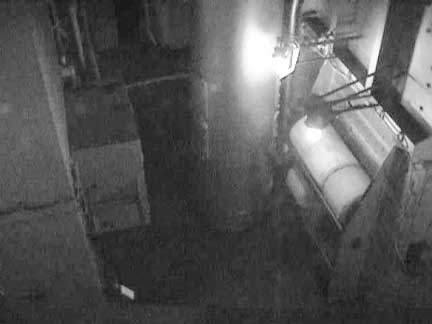 |
|
Three bags of propellant are shown in the lift. |
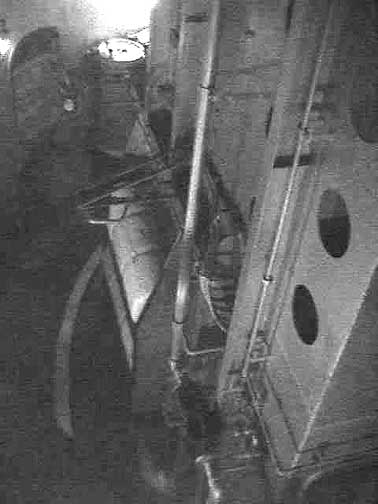 |
|
|
Why leave the extra space empty? Nothing, especially nothing that used power, was placed inside the magazine unless absolutely necessary. The second floor "balcony" overlooking the turntable contains a ring for storing projectiles. While the powder is stored outside the turret, at the turntable level and one floor higher, the projectiles are stored inside the turret. A bag of propellant weighs 90 pounds. A projectile weighed from 1,800 to 2,700 pounds. It makes sense to store the heavier component closer to the gun.
The turret combination is six floors high in all. At the base is the turntable, then the balcony level for storing shells, then two more levels of shells, then the "electrical" floor containing drive equipment to turn the turret and raise the guns. Finally, above the deck, is the exterior visible component of the turret. The entire assembly, from the turntable to the guns and armor, weighed as much as the destroyer Kennedy anchored next to the Massachusetts.
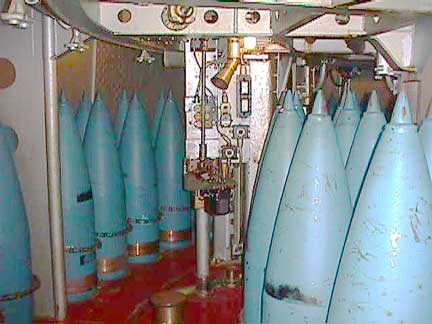 |
|
A Shell Magazine |
The final three pictures are of the middle level of the shell magazine. The blue painted practice rounds above are 1,800 pound 16" 50 caliber shells. Four rows of shells line the walls of another ring shaped room.
 |
|
Note the voice powered speaker tube, above. |
 |
|
|
The magazine is split. The outer two circles of shells are resting on a floor attached firmly to the ship. The inner two rings of shells are resting on floor attached to the turret, and rotate with the turret. The middle ring, and the three shell hoists that move shells up to the upper level magazine, rotate independently.
 |
Shore - Dock -
Engines - Dry-dock
- Perspectives
Anchor - 16 Inch -
George - Turret 3
- Shells - Magazines
- Jean Bart - Armor
Hatches - Five
Inchers - Inside 5" - Quad
40s - Turkey Trot
AA Directors - Sky -
Spot - Radar -
Last Look - History
- BB Names
Massachusetts - Galveston
- Homepage - NavShips
& NavRing